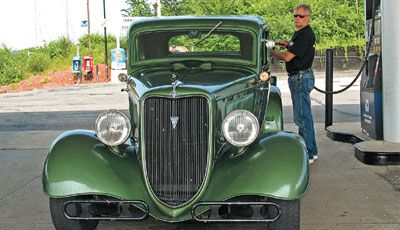
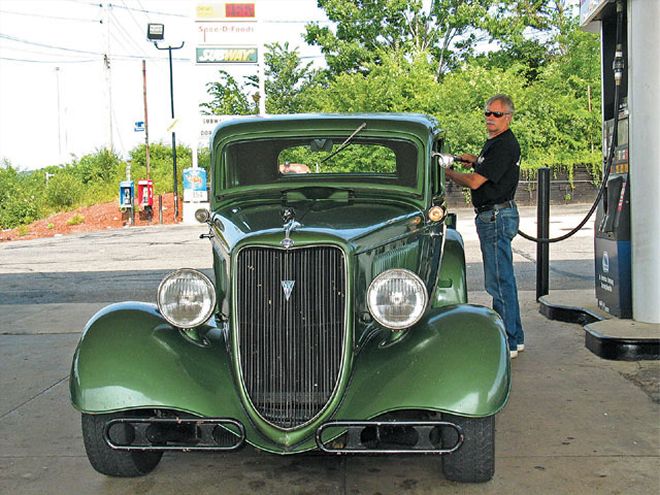
It might be too early to say for sure how the use of biofuels will effect the environment, our dependency on fossil fuels, or even food supplies. But as more states have mandated the use of ethanol in pump gasoline, some hot rodders with older carbureted engines have noticed negative effects.
Ethanol is an alcohol-based fuel that is typically mixed with gasoline in a ratio of 10-percent ethanol to 90-percent gasoline, leading to the term E-10 to describe such fuel. New cars are designed to run E-10 pump gas with unnoticeable negative effects.
Racers using ethanol in greater concentrations know that alcohol burns faster and requires richer jetting than gasoline. Boaters have to deal with ethanol's ability to hold water, causing rust, and with the effects of dissolved fiberglass deposits contaminating engines. Other articles in other places have dealt with these issues.
Hot rodders running early-style carburetors frequently have problems with the effect of ethanol on rubber components, especially in the accelerator pumps
The guys at Blundell Speed and Machine told us that a number of their customers who are running pump gas through some of those older carburetors are complaining of bogging when they hit the throttle. In many cases, Chad Blundell has been able to trace the problem to the accelerator pump, particularly in Rochester 2Gs, and other older carbs.
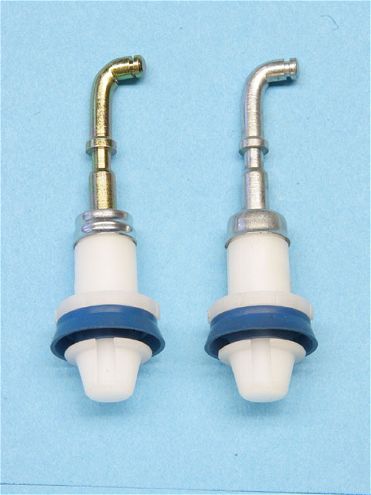 These accelerator pumps are from a large bore Rochester 2G, liked you'd see on a Pontiac or Olds. The blue tone of the synthetic rubber cups identifies the material as Viton, a fluoropolymer elastomer made by DuPont. The two cups look and feel almost identical even though the one on the right is used and the other is brand new. It is highly resistant to the chemical effects of ethanol and other additives in pump gas. If you've been experiencing pump failure, installing a replacement featuring Viton could be your solution.
These accelerator pumps are from a large bore Rochester 2G, liked you'd see on a Pontiac or Olds. The blue tone of the synthetic rubber cups identifies the material as Viton, a fluoropolymer elastomer made by DuPont. The two cups look and feel almost identical even though the one on the right is used and the other is brand new. It is highly resistant to the chemical effects of ethanol and other additives in pump gas. If you've been experiencing pump failure, installing a replacement featuring Viton could be your solution.
The bog is the result of air being delivered into the carburetor faster than fuel when the throttle is opened suddenly, causing a lean mixture. The accelerator pump is a plunger activated by the throttle linkage, providing a quick shot of raw fuel into the primary bore to prevent that lean condition.
The accelerator pumps consist of a flexible cup fitted around a piston. These cups are made from either leather or different types of molded rubber. If the cup material used is not resistant to the ethanol and other additives in modern fuels, it will wear out, sometimes very quickly, resulting in the type of failure that Chad sees all the time. If you're replacing accelerator pumps faster than you're replacing air fresheners, the problem is the wrong type of material being used; the solution is using the right type.
Leather, Rubber, and Better Rubber
The three materials commonly used for accelerator pumps are leather, Buna-N rubber, and Viton rubber. Standard Motor Products manufactures accelerator pumps under the brand name Hygrade, and uses all three materials in its products. David Goldstein in Quality Assurance at Standard told us about each of them
Leather has been around as long as cows. Its use in automotive applications goes back to the beginning, long before ethanol was an issue, and before rubber technology had come very far. Stromberg kits typically still use leather pumps. Leather is fairly resistant to the chemical effects of alcohol and gasoline, as opposed to the types of rubber from that period, which would dissolve and gel up when exposed to gasoline. But leather is not impervious to wear and tear or to heat, and not as flexible and easy to work with as rubber. As rubber material was developed, it surpassed leather in its ability to hold its shape, and to stretch over an accelerator pump piston
Buna-N rubber is a synthetic rubber originally developed in Germany in the '30s. Buna-N is oil resistant which is why it is a common material used for O-rings. It also stands up extremely well against petroleum products, including good old-fashioned gasoline, which made it an excellent material for accelerator pumps prior to the addition of ethanol-which causes deterioration
Viton is a registered trademark of DuPont and the name of a newer type of synthetic rubber. Unlike Buna-N, Viton is impervious to alcohol as well as to moisture and solvents. David said that Standard has tested Viton to 15-percent alcohol exposure, but they believe that it could be exposed to higher amounts without showing any damage-but those tests haven't been done yet. For the moment, Viton (or other brands identified as ethanol-compatible or non-corrosive) is the best solution to the problem of accelerator pump failure.
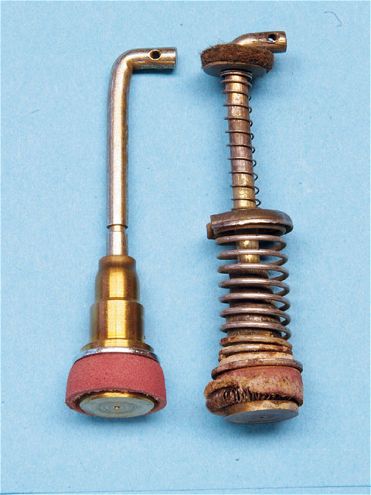 These two accelerator pump plungers are out of Stromberg carburetors, and feature leather cups. Leather is the only material available for Stromberg accelerator pumps. The pump on the left is new and perfect. The one of the right has been in use and eventually failed. Although leather holds up fairly well against the chemical components of fuel, it is not as flexible as rubber, and is more affected by heat, and gets dried out and chewed up over time.
These two accelerator pump plungers are out of Stromberg carburetors, and feature leather cups. Leather is the only material available for Stromberg accelerator pumps. The pump on the left is new and perfect. The one of the right has been in use and eventually failed. Although leather holds up fairly well against the chemical components of fuel, it is not as flexible as rubber, and is more affected by heat, and gets dried out and chewed up over time.
If pump gas continues to include greater percentages of ethanol, the rubber industry may have to, once again, develop and manufacture another new type of material in the future.
Aftermarket Carb Components
We called around to find out how the existing carb manufacturers have been addressing the fuel-compatibility problems experienced by hobbyists. Holley has been paying attention, according to Matthew Held, our inside source there, who confirmed that the company is staying on top of the materials they're using for components exposed to ethanol. Although they don't currently have product updates for older, out-of-production carburetors, Holley's current products are E-10 compatible.
At Kanter Auto Products, which provides parts for vintage tin, including early carburetors, Dan Winget told us that the rubber used in the company's rebuilt carbs has been modified to remain compatible with ethanol and other components in today's pump gas.
Other Parts
If ethanol has such a deteriorating effect on accelerator pump cups, is it also affecting other parts of the fuel system? Chad Blundell says he hasn't seen a problem with stationery parts that are not in constant movement-like the accelerator pump is-and are less prone to failure
Even so, here are a couple of tips to stay on the safe side:
*Replace existing fuel lines with fuel-injection grade lines which are more resistant to alcohol-or with Teflon lines which are impervious to deterioration.
*Protect floats with clear, moisture-cured urethane-one coat for brass floats, three for new cork floats.
*Try to avoid leaving components in constant contact with ethanol by flushing the system if the car is not going to be driven for a while.
*Replace the fuel in your tank every few weeks if not driving the car. Gasoline has a long shelf life, but ethanol blends have a shelf life of approximately 90 days, after which components begin to separate. Exposure to moisture speeds up the process.
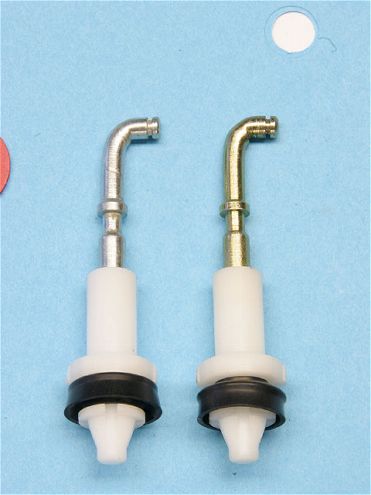 These two accelerator pump plungers are from a Rochester 2G small bore carburetor, the kind frequently favored for tri-power applications. The rubber cups on these pumps are Buna-N synthetic rubber. Buna-N served its purpose well before the days of ethanol, but doesn't hold up well with the alcohol content of modern gas, which can cause the material to swell, and deteriorate. It may not look deteriorated, but look closely at the used cup on the right and notice that it has pulled itself inside-out and no longer fits correctly on the piston. If you could touch it, you'd notice that it is hard and has lost its elasticity.
These two accelerator pump plungers are from a Rochester 2G small bore carburetor, the kind frequently favored for tri-power applications. The rubber cups on these pumps are Buna-N synthetic rubber. Buna-N served its purpose well before the days of ethanol, but doesn't hold up well with the alcohol content of modern gas, which can cause the material to swell, and deteriorate. It may not look deteriorated, but look closely at the used cup on the right and notice that it has pulled itself inside-out and no longer fits correctly on the piston. If you could touch it, you'd notice that it is hard and has lost its elasticity.
Boil Bubble, You're In Trouble
The addition of ethanol, as well as increased oxygenation, and the removal of lead, has lowered the boiling point of pump fuel significantly in the last few decades. Boiling fuel is the cause of vapor lock, a common problem with older carbureted cars. New cars are built to compensate for this change, but older cars weren't.
The fuel boiling point can be raised by pressurizing the fuel, using a high-pressure electric fuel pump located close to the fuel tank.
Lead additives, where legal, can fight the effects of ethanol gas by raising the fuel boiling point. Tetraethyl lead was first added to gasoline in the U.S. in the '20s to improve burn and reduce detonation and was phased out of pump gas starting in the '70s for health and environmental reasons. Products like Max Lead 2000 (www.maxlead2000.com), which is genuine tetraethyl lead, boost octane and increase the boiling point by as much as 30 degrees which reduces detonation and improves driveability in engines with 9.5:1 and higher compression ratios. These products cannot be used in cars requiring unleaded fuel or equipped with catalytic converters.
Let's Light This Candle
Since the lower octane and higher alcohol content in today's pump gas affects burning characteristics by changing the flash point, optimum performance requires a change in ignition timing. John Cause at Ignition Engineering told us that most hot rods burning today's pump gas can't run as much timing as they could in the past without experiencing detonation problems. Advancing the timing will help with throttle response but will increase the risk of detonation. Reducing the total timing will help avoid that condition.
There is no plug-in formula-since engine, compression, carburetor size, camshaft, rearend ratio, overdrive, and other factors all affect timing-but as a starting point, John recommends recurving the distributor for an increase in initial timing at idle (to as much as 10 or 12 degrees or more Before Top Dead Center) and a reduction in total timing down to 34 degrees.
Cheat Sheet
Your best ally in avoiding accelerator pump problems is a good auto parts store counterman. Blundell Speed and Machine provided this chart (below) of carburetors commonly used by hot rodders and the various accelerator pumps available for them, listed by pump manufacturer part number. An educated counterman (they still exist) will be able to find these parts numbers in his parts books and determine which are available with leather, Buna-N, or ethanol-resistant rubber (Viton) parts.